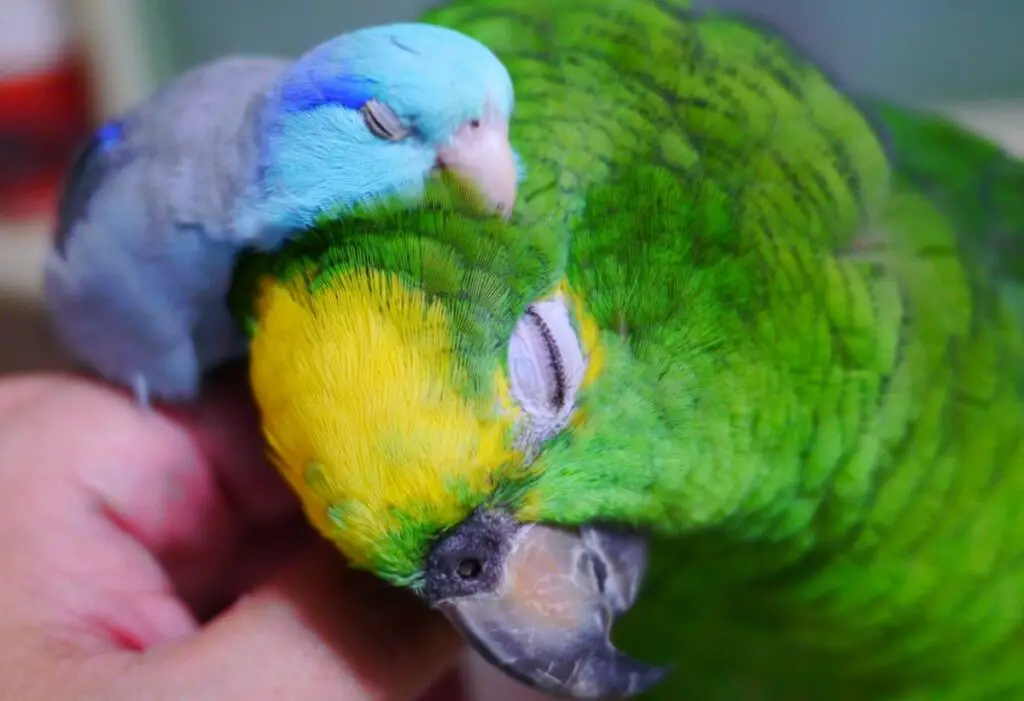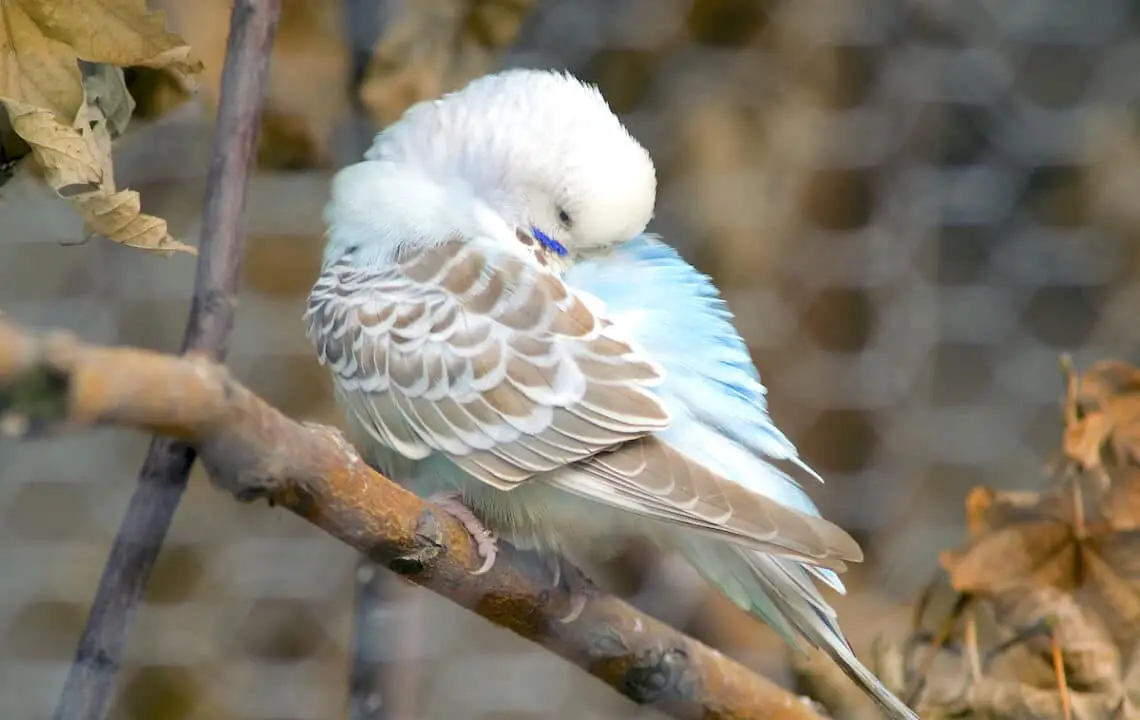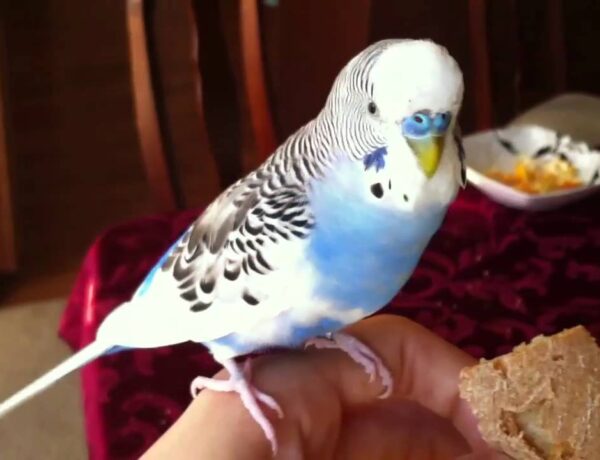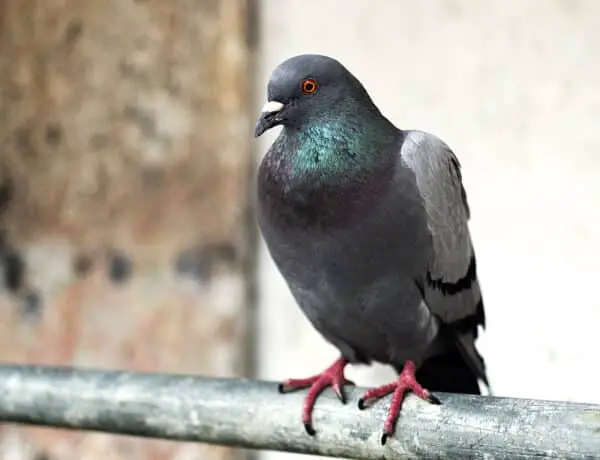Introduction
How Do Parakeets Sleep: Parakeets, charming and vibrant members of the parrot family, exhibit unique behaviors even when it comes to something as seemingly mundane as sleep. Understanding how parakeets sleep unveils fascinating aspects of their biology and instincts. Unlike humans, who generally experience a consolidated block of sleep during the night, parakeets are known for their fragmented sleep patterns. In the wild, these small, colorful birds often roost in flocks high in trees, where they take short naps interspersed throughout the day and night.
This distinctive sleep pattern serves both as a survival strategy, allowing them to remain vigilant against potential predators, and as a means to conserve energy. The sleeping habits of parakeets are also heavily influenced by their domestic environment. Pet parakeets, or budgerigars, have adapted to the routines of their human caregivers. As diurnal creatures, they tend to synchronize their sleep patterns with the household’s day-night cycle.
Owners often observe their parakeets parrots taking brief naps during the day, especially if the surroundings are relatively quiet. Creating a comfortable and secure sleeping environment is crucial for these birds, as disturbances or exposure to excessive light during their sleep can lead to stress and disrupted rest. Understanding the nuances of how parakeets sleep is essential for pet owners to ensure the well-being and contentment of these delightful avian companions.

How do I know if my parakeet is sleeping?
A healthy sleeping position for a parakeet includes their head tucked into their neck or their head resting on their back. They will be perched on one foot with the other tucked into its belly.
Recognizing when your parakeet is sleeping involves observing its behavior and physical cues. Parakeets, like many birds, have distinctive ways of indicating when they are resting. Here are some signs that your parakeet is likely sleeping:
Quieter and Calmer Demeanor: When a parakeet is sleeping, it tends to be more subdued and calm. If your bird is usually active and vocal during waking hours, you may notice a significant decrease in chirping and movement when it’s time for rest.
Closed Eyes: While it might seem obvious, a sleeping parakeet typically has its eyes closed. However, it’s essential to note that sometimes birds can rest with one eye closed while keeping the other open for safety, especially if they feel insecure in their environment.
Altered Body Position: Parakeets often change their body position when sleeping. They might tuck their head under their wing or fluff up their feathers to stay warm. Some birds even sleep while perched on one leg.
Reduced Activity: Naturally, a sleeping parakeet will exhibit decreased activity. If your bird is usually hopping around, playing with toys, or exploring its cage and suddenly becomes still, it’s likely taking a nap or settling down for the night.
Diminished Responsiveness: While parakeets are generally alert and responsive, they may become less reactive when they are sleeping. Gentle movements or sounds may not elicit the usual response if your bird is in a state of rest.
It’s crucial to respect your parakeet’s sleep needs and provide a quiet, dimly lit environment during its resting periods. Remember that, like humans, birds have different sleep cycles, and some may nap briefly during the day while having more extended periods of sleep during the night. Observing your parakeet’s behavior will help you understand its individual sleep patterns and preferences.
Do parakeets need to be covered at night?
As long as a dark, quiet and somewhat secluded area is provided for a bird to sleep in, most will be fine without being covered at night. Remember, however, that sleep is vital to a bird’s well-being. If you are in doubt about your pet’s reaction to being uncovered, play it safe and resume covering the cage at night.
Covering a parakeet’s cage at night is not an absolute necessity, but it can offer several benefits to the bird’s well-being. Parakeets, like many birds, are sensitive to changes in light and may be disturbed by ambient lights in the room during the night. Here are some reasons why covering a parakeet’s cage at night might be beneficial:
Undisturbed Sleep: Covering the cage can create a dark and quiet environment, which helps mimic the natural sleeping conditions for parakeets. This darkness encourages undisturbed sleep, allowing the bird to rest properly and maintain good health.
Reduced Stress: Parakeets can be sensitive to changes in their environment, and sudden movements or noises during the night might stress them. A cover provides a sense of security and privacy, reducing potential stressors that could disrupt their sleep.
Regulation of Sleep Cycles: Parakeets, like many birds, are diurnal, meaning they are most active during the day. Covering the cage helps regulate their sleep-wake cycles, preventing exposure to artificial lights during the night that might interfere with their natural circadian rhythms.
While covering the cage is generally beneficial, it’s important to ensure proper ventilation. The cover should be breathable, allowing fresh air to circulate through the cage. It’s advisable to gradually introduce the covering routine to give your parakeet time to adjust.
That individual parakeets may have different preferences, and some birds might feel more comfortable with a partially covered cage or no cover at all. Observing your parakeet’s behavior and adjusting accordingly will help you determine what works best for your feathered friend.
Do parakeets sleep hanging?
Your parakeet might perch as high as possible in its cage and then hang down to sleep. Besides hanging upside down, they can also turn their heads 180 degrees, engage in large stretches and puff themselves up, often before taking a lunchtime nap. They often grind their beaks while they are sleeping.
Yes, parakeets and many other species of parrots are known to sleep while perched, often on one leg. This behavior is perfectly natural for them and is an adaptation to their wild environments. While sleeping, a parakeet may tuck its head under its wing and fluff up its feathers for warmth.
The ability to sleep while perched is a result of a specialized tendon locking mechanism in their legs. This mechanism allows them to lock their feet onto a perch, providing a secure grip even while they are asleep. Additionally, sleeping on one leg helps them conserve body heat, a crucial aspect, especially in the wild where temperatures can drop during the night.
In a domestic setting, it’s common to find pet parakeets sleeping while perched on a comfortable perch within their cage. Providing a variety of perches with different diameters and textures can help keep their feet healthy and provide them with options for sleeping. It’s also essential to ensure that the environment is conducive to rest, with minimal disturbances and appropriate lighting during their sleeping hours.
Do birds need darkness to sleep?
When the researchers looked into the consequences of sleeping under light, they found no effect of nightly illumination on the birds’ memory and learning, and their blood levels did not show any indication of sleep disruption. However, both light sources caused the birds to be more active at night.
Yes, in general, most birds, including parakeets, benefit from a dark or dimly lit environment during their sleep. Like humans, birds have a natural circadian rhythm that is influenced by light and darkness. Providing a dark or low-light environment helps them maintain a more natural sleep-wake cycle. Here are a few reasons why darkness is beneficial for birds during sleep:
Mimicking Natural Conditions: In the wild, birds experience natural light changes with the rising and setting of the sun. Darkness signals to them that it’s time to rest. Providing a dark environment in captivity helps mimic these natural conditions, promoting a healthy sleep pattern.
Undisturbed Sleep: Birds are more likely to experience undisturbed sleep in a dark environment. Excessive light or sudden changes in lighting can disrupt their sleep and stress them out. A dark or dimly lit room creates a calm and quiet atmosphere conducive to rest.
Maintenance of Circadian Rhythms: Exposure to natural light during the day and darkness during the night helps regulate a bird’s circadian rhythms. This regulation is essential for various physiological and behavioral functions, including proper sleep and wake cycles.
While darkness is generally beneficial, some birds may have individual preferences. It’s a good idea to observe your bird’s behavior and adjust the level of darkness based on its responses. Covering the cage with a breathable material at night can help create a cozy and secure sleeping environment for your pet bird. Providing a consistent sleep routine is important for the overall well-being of birds in captivity.
What do parakeets like in their cage?
Parakeets like a bit of variety in their cages, and it will keep them alert and entertained if you change their toys around regularly. However, there are certain items that should be fixed features, including perches, swings, mineral blocks, and feeding and drinking apparatus.
Creating an enriched and comfortable environment inside the cage is essential for the well-being of parakeets. Here are some items and features that parakeets typically enjoy in their cages:
Perches: Offer a variety of perches with different diameters and textures. This helps keep their feet healthy and provides opportunities for exercise. Natural wood perches are excellent choices.
Toys: Parakeets are intelligent and playful birds that benefit from mental stimulation. Include a variety of toys such as swings, bells, mirrors, and puzzle toys to keep them entertained.
Cuttlebone and Mineral Blocks: These provide a source of calcium and essential minerals for your parakeet’s beak and overall health. They can also help keep their beaks trimmed.
Swings and Ladders: Swings and ladders add an extra dimension to the cage, providing opportunities for physical activity and play. Parakeets enjoy swinging and climbing.
Food and Water Bowls: Ensure that the food and water bowls are easily accessible and securely attached to the cage. Stainless steel bowls are a good choice as they are easy to clean and durable.
Vegetables and Treats: Parakeets enjoy a varied diet. Include fresh vegetables, fruits, and occasional treats. This not only provides nutritional variety but also adds an element of foraging and exploration.
Cuttlefish Bones and Shells: These are excellent sources of calcium, and parakeets often enjoy nibbling on them. They also provide a beak workout.
Nesting Box: If you have a pair of parakeets and are open to breeding, a nesting box can provide a secure and comfortable space for them.
Privacy Hut or Tent: Some parakeets enjoy having a cozy, enclosed space where they can retreat for privacy and rest. These huts or tents can serve as a comfortable sleeping spot.
Safe Chew Toys: Parakeets love to chew, and providing safe chew toys helps keep their beaks healthy and satisfies their natural chewing instincts.
What time should I put my parakeet to bed?
Let them sleep as long as they can. Unless their bird cages are covered, birds usually awaken when the sun comes up. Keep in mind that your bird should have at least 10 hours of darkness, so if the sun rises at 6:30 a.m., you should not keep your bird up past 8:30 p.m. the night before.
Parakeets, like many birds, benefit from having a consistent sleep routine. It’s generally recommended to put your parakeet to bed when the sun sets, or shortly thereafter. Since parakeets are diurnal, meaning they are most active during the day, they will naturally be more inclined to sleep when it gets dark.
Here are some general guidelines for putting your parakeet to bed:
Dusk: Aim to have your parakeet settled into its sleeping area shortly after dusk when the natural light is diminishing. This helps mimic their natural sleep-wake cycle.
Consistent Schedule: Establish a consistent bedtime routine for your parakeet. This can include dimming the lights in the room or covering the cage with a breathable cloth. Consistency in the sleep schedule helps regulate their circadian rhythms.
Avoid Disturbances: Ensure that the room remains quiet and free from disturbances during your parakeet’s sleeping hours. Sudden noises or changes in lighting can disrupt their sleep.
Adequate Sleep: Parakeets generally need around 10 to 12 hours of sleep per night. Providing them with enough undisturbed sleep is crucial for their health and well-being.
Remember that individual parakeets may have slight variations in their preferences, so observe your bird’s behavior to determine the most suitable bedtime routine. Creating a comfortable, dark, and quiet sleeping environment will contribute to your parakeet’s overall happiness and health.
How long do parakeets live as pets?
7 to 10 years
On average Parakeets live a good 7 to 10 years when they are healthy and well taken care of. There are several factors that contribute to the lifespan of a Parakeet. Such as their diet and living environment
The lifespan of a pet parakeet, or budgerigar, can vary depending on factors such as genetics, diet, living conditions, and veterinary care. On average, parakeets can live between 7 to 15 years. However, with proper care, some parakeets have been known to live even longer.
Here are some factors that can contribute to the longevity of pet parakeets:
Diet: Providing a balanced and nutritious diet is essential for the health of parakeets. A diet that includes a variety of fresh vegetables, fruits, high-quality pellets, and seeds will contribute to their overall well-being.
Environment: Creating a safe and enriched living environment is crucial. This includes a clean cage, appropriate perches, toys for mental stimulation, and a well-maintained living space.
Healthcare: Regular veterinary check-ups and prompt attention to any signs of illness are important for extending the lifespan of a parakeet. Early detection and treatment of health issues can make a significant difference.
Social Interaction: Parakeets are social birds and benefit from regular interaction and mental stimulation. Loneliness and boredom can have negative effects on their health, so providing companionship and engaging activities is essential.
Avoiding Toxins: Keeping the environment free from potential hazards, such as toxic plants, fumes, and unsafe objects, is crucial for the health and safety of your parakeet.
Do parakeets close their eyes?
Alert and healthy birds usually have both eyes wide open while awake. If the eyes start closing, and it’s not because you’re scratching a birdie head and inducing pure birdie joy, the bird might be sick. Oh, and be careful: birds often close one eye but not the other.
Yes, parakeets, like many other birds, have the ability to close their eyes. Birds close their eyes for various reasons, and it’s a natural behavior associated with resting, sleeping, or even feeling secure.
When a parakeet is sleeping or taking a nap, it will typically close its eyes. This helps them rest and conserve energy. Parakeets have a specialized adaptation called the nictitating membrane or “third eyelid,” which is a thin, translucent membrane that can cover their eyes partially while they sleep. This membrane helps protect their eyes and keeps them moist.
Closing their eyes can also be a sign of comfort and relaxation. If your parakeet is perched in a content and safe environment, it may close its eyes as a way of expressing a sense of security.
Observing your parakeet’s behavior, including eye movements and body language, can provide insights into its well-being and emotions. If a parakeet keeps its eyes closed during the day when it’s typically active, it might be an indication of illness or stress, and a veterinarian should be consulted for proper evaluation and care.

Conclusion
The intricate sleep patterns of parakeets shed light on the adaptability and resilience of these charming avian companions. Their fragmented sleep, reminiscent of their wild roosting habits, highlights the evolutionary strategies that have allowed them to thrive in diverse environments. Whether in their natural habitats or domestic settings, parakeets exhibit a keen sense of alertness even during rest, a behavior rooted in their need to stay vigilant against potential threats. As responsible pet owners, understanding and respecting these sleep patterns becomes imperative to foster a healthy and stress-free environment for our feathered friends.
Creating a conducive sleeping space for parakeets cannot be overstated. Minimizing disturbances and ensuring an appropriate light-dark cycle aligns with their natural diurnal tendencies. A well-rested parakeet is likely to be more vibrant, sociable, and overall, a happier companion. As we delve into the intricacies of how parakeets sleep, it becomes evident that our efforts to harmonize their sleep patterns with our daily routines are not merely considerations for their physical health but are integral to nurturing a bond based on trust and well-being.
In the broader context, the study of parakeets sleep patterns contributes to our understanding of avian behavior and the fascinating ways in which different species adapt to their surroundings. By appreciating and accommodating the unique sleep needs of parakeets, we not only enhance their quality of life but also deepen our connection with these intelligent and charismatic birds.





No Comments